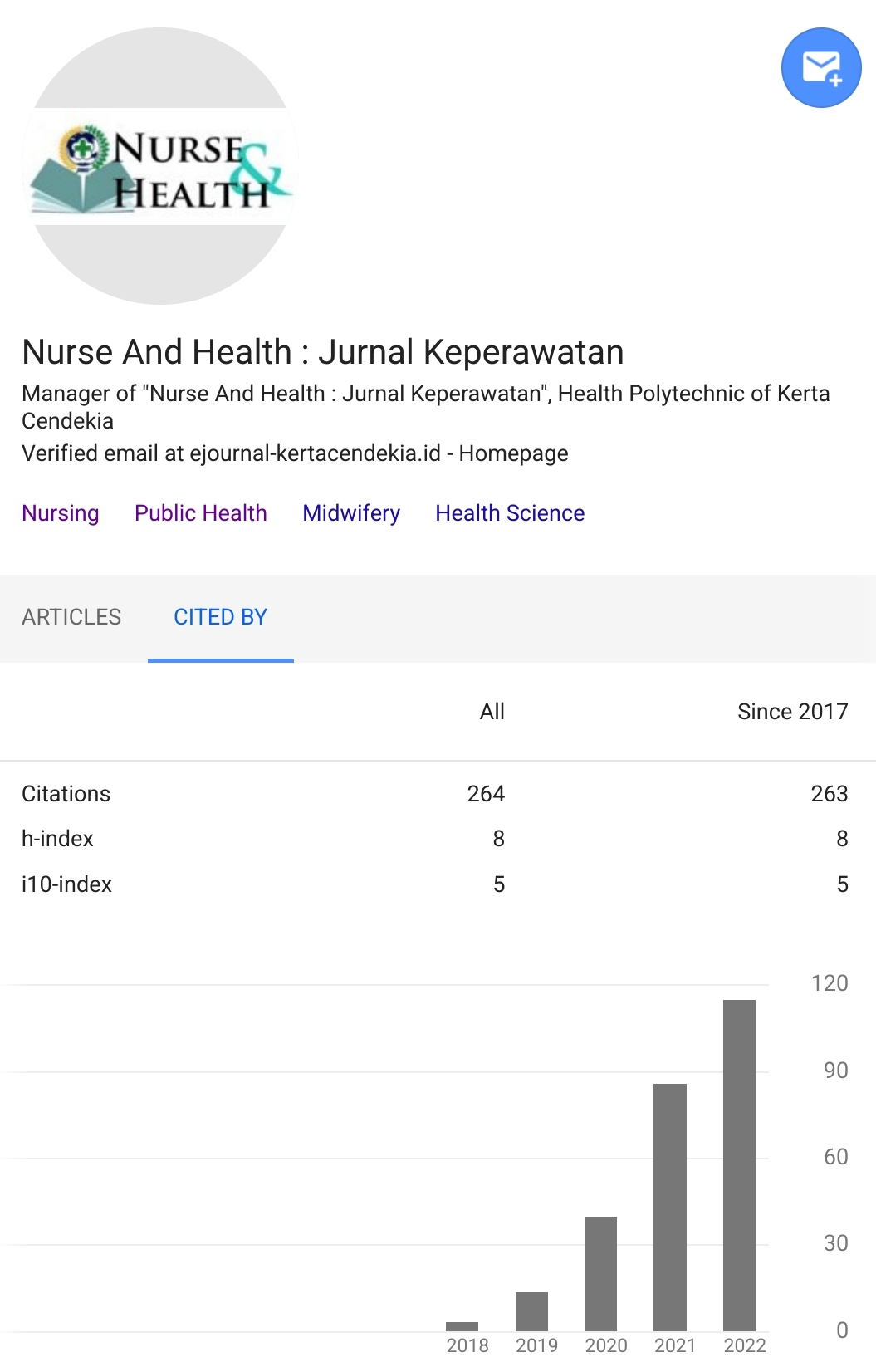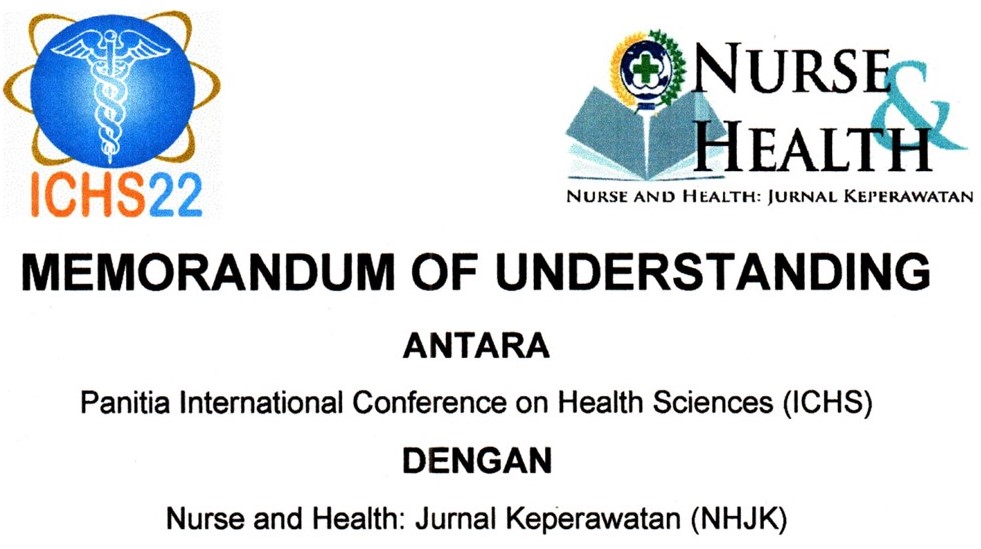ROLE OF FAMILY IN IMPLEMENTATION OF DIABETES EXERCISE IN TYPE 2 DIABETES MELITUS PATIENTS
Abstract
Introduction: Diabetes mellitus is a group of metabolic diseases characterized by an increase in blood glucose levels (hyperglycemia), which occurs due to abnormal insulin secretion, insulin activity and both (Brunner & Suddarth, 2014). The role of the family is needed for diabetics related to well-being and health where the family environment is a place for individuals to learn for life (Friedman, 2010). The role of the family is the most powerful indicator in giving a positive impact on the implementation of diabetes exercise which acts as a glicemic control which is controlling and regulating blood sugar levels.Objective: The aim of the study was to describe the role of families in implementing diabetes exercise in type 2 Diabetes Mellitus (DM) patients at Gayungan Health Center, Dukuh Menanggal, Surabaya.Method: The design of this study used descriptive research. The population is all families who have family members with diabetes mellitus cases with a large sample of 4O people. Sampling using the Total sampling technique The variables studied were the role of family in implementing diabetes exercise. Data collection is done by distributing questionnaires.Results: The results of the study showed that of the 40 respondents in the Gayungan Community Health Center working area in Dukuh Menanggal dated 40% the role of good family, 32.5% was sufficient, 27.5 was lacking in supporting the implementation of diabetes exerciseConclusion: The family role of almost half is in the good category. The family should play an active role in the management of diabetes exercises in family members who suffer from diabetes mellitus so that blood glucose levels can be controlled properly. Keywords: The role of the family, diabetes exercise, diabetes mellitus.Downloads
References
Agus, S. (2007). Pengaruh Latihan Fisik; Senam Aerobik Terhadap PenurunanKadar Gula Darah Pada Penderita DM Tipe 2 di Wilayah Puskesmas Bukateja Purbalingga. Semarang: PSIK FK UNDIP
American Diabetes Association (ADA). 2012. Diagnosis and Classification of Diabetes Mellitus. Diabetes Care Journal, 35(1), 64-71.
Brunner & Suddarth. 2014. Keperawatan Medikal Bedah. Edisi 8. Volume 2. Jakarta: EGC.
Carpenito, L. J. (2013). Diagnosa Keperawatan: Aplikasi pada Praktek Klinik (Terjemahan). Edisi 6. Jakarta: EGC.
Friedman, MM.Bowden, VR,& Jones, EG. (2010). Buku Ajar Keperawatan Keluarga Teori dan Praktek. Alih bahasa, Akhir Yani S.Hamid dkk; Ed.5 Jakarta: EGC.
Friedman. (2014). Buku Ajar Keperawatan Keluarga Riset, Teori, & Praktik. Jakarta : ECG.
Guyton & Hall. (2012). Buku Ajar Fisiologi Kedokteran. Edisi 11. Jakarta: EGC.
Hensarling, J. (2009). Development and Psychometric Testing of Hensarling’s Diabetes Family Support Scale. a disertation Degree of Doctor of Philosophy in the Graduate Shool of Texa’s Women’s University. Retrieved from www.proquest.com on January 10, 2013.
Kariadi KS, Hartini. (2009). Diabetes? Siapa takut!!. Bandung: Qanita.
Lanywati, Endang. (2011). Diabetes Mellitus Penyakit Kencing Manis. Yogyakarta: Arcan.
Mahendra, B. (2008). Care yourself, Diabetes Mellitus. Jakarta: Penebar Plus.
Maulana, Mirza. (2009). Mengenal Diabetes Mellitus: Panduan Praktis Menangani Penyakit Kencing Manis. Jogjakarta: Katahati.
Mills. L. (2008). Diabetes: Self-Esteem and Family Suport. Retrieved from http://www.americanchronicle.com on May 7, 2013.
Misnadiarly. (2006). Diabetes Mellitus Mengenali Gejala Menanggulangi Mencegah Komplikasi. Jakarta: Pustaka Popular Obor.
Mistra (2010). Tiga Jurus Melawan Diabetes Melitus. Jakarta: Graha Medika.
Notoatmodjo, Soekidjo. (2005). Metodologi Penelitian Kesehatan. Jakarta: Rhineka Cipta.
Nursalam.(2008). Proses dan dokumentasi keperawatan konsep dan praktik. Edisi 2. Jakarta: Salemba Medika.
Rifki, N.N. (2009). Penatalaksanaan Diabetes dengan Pendekatan Keluarga, dalam Sidartawan, S., Pradana,S & Imam, S. Penatalaksanaan Diabetes Terpadu. Jakarta: Balai Penerbit FKUI.
Riset Kesehatan Dasar. (2013). DM di Indonesia. Jakarta. Retrieved from http://www.depkes.go.id on May 8, 2018.
Widianti, Anggriyani Tri, & Atikah Proverawati. 2010. Senam Kesehatan. Yogyakarta: Nuha Medika.
World Health Organization. (2013). Prevalensi Diabetes Melitus di Indonesia. Retrieved from http://www.depkes.go.id. On January 3, 2014.
Authors who publish with Nurse and Health: Jurnal Keperawatan agree to the following terms:
- Authors retain copyright licensed under a Creative Commons Attribution-NonCommercial 4.0 (CC BY-NC 4.0), which allows others to remix, tweak, and build upon the authors' work non-commercially, and although the others' new works must also acknowledge the authors and be non-commercial, they don't have to license their derivative works on the same terms.
- Authors are permitted and encouraged to post their work online (e.g., in institutional repositories or on their website) prior to and during the submission process, as it can lead to productive exchanges, as well as earlier and greater citation of published work (See The Effect of Open Access). Authors can archive pre-print and post-print or publisher's version/PDF.






















